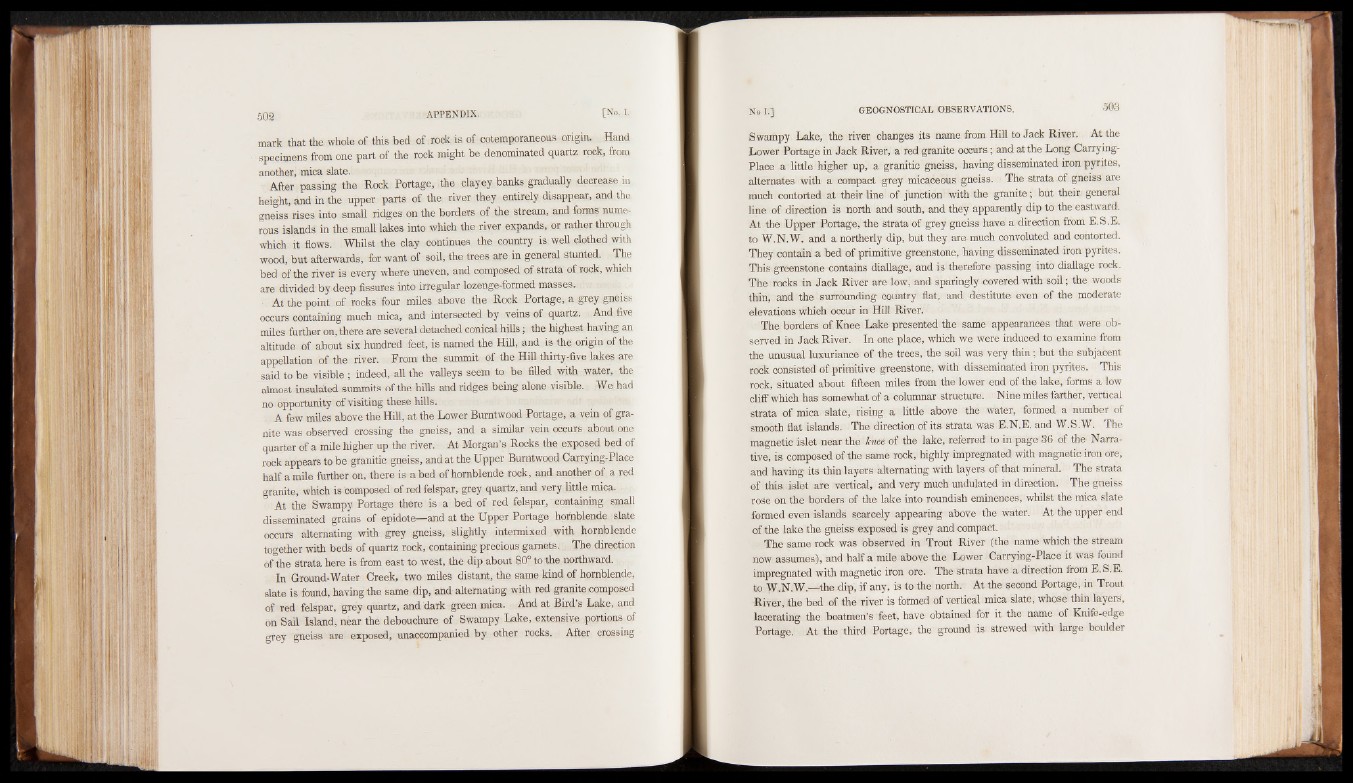
mark that the whole of this bed of rock is of cotemporaneous origin. Hand
specimens from one part of the rock might be denominated quartz rock, from
anAotfhteerr, pmaiscsai nslga tteh.e Rock Portage, the clayey banks gradually decrease in
height, and in the upper parts of the river they entirely disappear, and the
gneiss rises into small ridges on the borders of the stream, and forms numerous
islands in the small lakes into which the river expands, or rather through
which it flows. Whilst the clay continues the country is well clothed with
wood, but afterwards, for want of soil, the trees are in general stunted. The
bed of the river is every where uneven, and composed of strata of rock, which
are divided by deep fissures into irregular lozenge-formed masses.
At the point of rocks-four miles above the Rock Portage, a grey gneiss
occurs containing much mica, and intersected by veins of quartz, And five
miles further on, there are several detached conical hills ; the highest having an
altitude of about six hundred feet, is named the Hill, and is the origin of the
appellation of the river. From the summit of the Hill thirty-five lakes are
said to be visible; indeed, all the valleys seem to be filled with water,-die
almost insulated summits of the hills andridges being alone visible. We had
n o o p p o rtu n ity o f v isitin g th e se h ills.
A few miles above the Hill, at the Lower Burntwood Portage, a vein of granite
was observed crossing the gneiss, and a similar vein occurs about one
quarter of a mile higher up the river. At Morgan’s Rocks the exposed bed of
rock appears to be granitic gneiss, and at the Upper Burntwood Carrying-Place
half a mile further on, there is a bed of hornblende rock, and another of a red
granite, which is composed of red felspar, grey quartz, and very little mica.
At the Swampy Portage there is a bed of red felspar, containing small
grains of epidote—and at the Upper Portage hornblende slate
occurs alternating with grey gneiss, slightly intermixed with hornblende
together with beds of quartz rock, containing precious garnets. The direction
of the Strata here is from east to west, the dip about 80° to the northward.
In Ground-Water Creek, two miles distant, the same kind of hornblende,
slate is found, having the same dip, and alternating with red granite composed
of red felspar, grey quartz, and dark green mica. And at Bird’s Lake, and
on Sail Island, near the debouchure of Swampy Lake, extensive portions of
grey gneiss are exposed, unaccompanied by other rocks. After crossing
Swampy Lake, the river changes its name from Hill to Jack River. At the
Lower Portage in Jack River, a red granite occurs; and at the Long Carrying-
Place a little higher up, a granitic gneiss, h av in g disseminated iron pyrites,
alternates with a compact grey micaceous gneiss. The strata of gneiss are
much contorted at their line of junction with the granite; but their; general
line of direction is north and south, and they apparently dip to the eastward.
At the Upper Portage, the strata of grey gneiss have a direction from E.S.E.
to W.N.W. and a northerly dip, but they, are much convoluted and contorted.
They contain a bed of primitive greenstone, having disseminated iron pyrites.
This greenstone -contains diallage, and is therefore passing into diallage rock.
The rocks in Jack River are low, and sparingly covered with soil; the woods
thin, and the surrounding country flat, and destitute even of the moderate
elevations which occur in Hill River. -
The borders of Knee Lake presented the same appearances that were observed
in Jack River. In one place, which we were induced to examine from
the unusual luxuriance of the trees, the soil was very thin; but the subjacent
rock consisted of primitive greenstone, with disseminated iron pyrites. This
rock, situated about fifteen miles from the lower end of the lake, forms a low
cliff which has somewhat of a columnar structure. Nine miles farther, vertical
strata of mica slate, rising a little above the water, formed a number of
smooth flat islands. The direction of its strata was E.N.E. and W.S.W. The
magnetic islet near the knee of the lake, referred to in page 36 of the Narrative,
is composed of the same rock, highly impregnated with magnetic iron ore,
and having its thin layers alternating with layers of that mineral. The strata
of tins islet are vertical, and very much undulated in direction. The gneiss
rose on the borders of the lake into roundish eminences, whilst the mica slate
formed even islands scarcely appearing above the water. At the upper end
of the lake the gneiss exposed is grey and compact.
The same rock was observed in Trout River (the name which the stream
now assumes), and half a mile above the Lower Carrying-Place it was found
impregnated with magnetic iron ore. The strata have a direction from E.S.E.
to TV.N.W.—the dip, if any, is to the north. At the second Portage, in Trout
River, the bed of the Tiver is formed of vertical mica slate, whose thin layers,
lacerating the boatmen’s feet, have obtained for it the name of Knife-edge
Portage. At the third Portage, the ground is strewed with large boulder